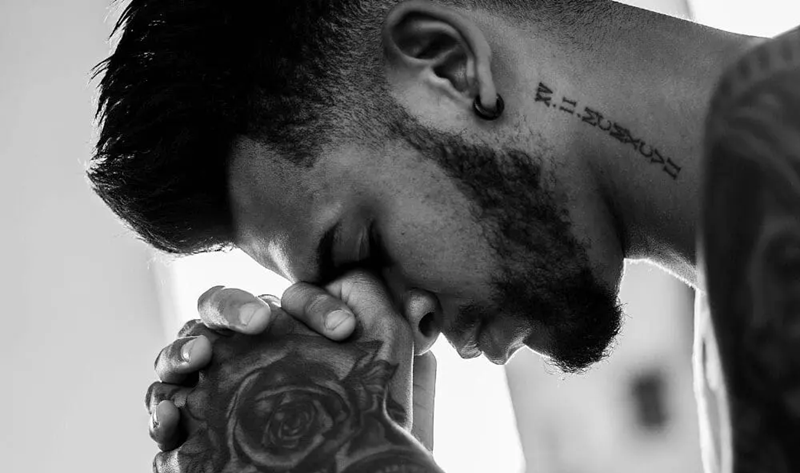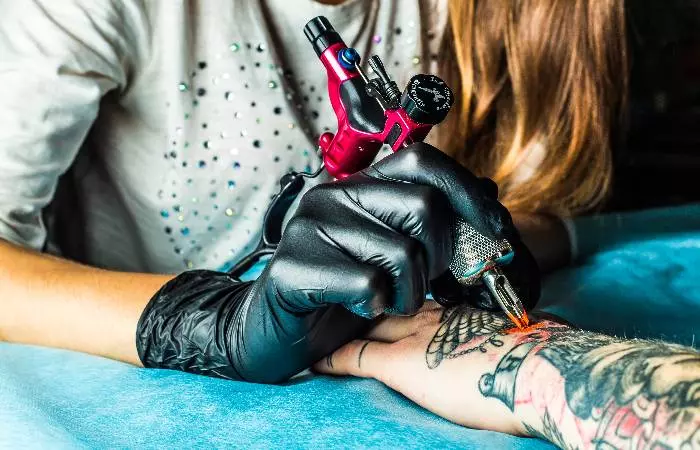People often get tattoos as a means of self-expression, a way to showcase their individuality and personal identity. Tattoos can serve as a visual narrative of one’s life journey, symbolizing significant moments, relationships, or personal beliefs. Some people choose to get tattoos as a form of tribute or memorial, commemorating loved ones or important events.
Cultural traditions and heritage also play a significant role in the decision to get tattooed, with many ancient societies viewing tattoos as sacred and powerful. For others, getting tattooed can be a form of rebellion, challenging societal norms and expectations.
Body art can also be seen as a form of aesthetic enhancement, a way to adorn the body much like jewelry or fashion. While the reasons vary greatly from person to person, there is often a deeply personal and meaningful story behind each tattoo. This form of body art allows individuals to wear their heart on their sleeve, quite literally, and provides a unique platform for self-expression.
Historical Significance of Tattoos
Tattoos hold a rich historical significance that varies greatly across different cultures and societies. The art of tattooing has been practiced for thousands of years dating back to Neolithic times, and the oldest evidence of human tattoos is believed to be from between 3370 BC and 3100 BC. The discovery of «Ötzi the Iceman,» a mummified human body with 61 tattoos, provided evidence of this ancient practice. Tattoos were used for a myriad of reasons including spiritual beliefs, rites of passage, and as a form of identification.
In Maori culture, for instance, tattoos, or «ta moko,» are symbolic of an individual’s social status, genealogy, and accomplishments. Similarly, in ancient Egypt, tattoos were primarily worn by women, serving as a form of protection during childbirth. In contrast, the Romans viewed tattoos as a mark of punishment, branding slaves and criminals with tattoos to signify their lowly status.
During the early Christian era, tattoos were used to denote religious devotion and pilgrimage. With the advent of the Age of Discovery, tattoos became a form of souvenir among sailors to mark their travels. In Japan, traditional tattoos, or «Irezumi,» began as a form of displaying status, but later became associated with the criminal underworld.
In contemporary society, the perception of tattoos has evolved significantly. While historically, tattoos were often associated with a lower societal status or criminality, they are now seen as a form of self-expression and individualism. They’ve become a mainstream aspect of global culture that transcends social, cultural, and age barriers.
The vast history of tattoos showcases the art form’s evolution from a social marker to a personal statement. It is a testament to the human desire for self-expression and identity, emphasizing the body as a canvas for art and personal narrative. The historical significance of tattoos thus lies in their ability to reflect societal norms, cultural beliefs, and personal ideologies throughout the ages.

Personal Expression and Identity
Personal expression is fundamental to understanding oneself and one’s identity. It is a complex, dynamic process that encompasses various aspects of life, including our thoughts, emotions, behaviors, and attitudes. The ability to express oneself is not only crucial for emotional well-being but also plays a significant role in shaping our identity. Through personal expression, we communicate our unique perspectives, experiences, and values to others, helping them understand who we are and what we stand for.
Personal expression can take many forms, such as art, music, dance, fashion, or writing. These mediums provide a platform for individuals to illustrate their inner world, narrate their stories, and share their perspectives. Each form of personal expression is a reflection of one’s identity, highlighting the individual’s uniqueness and diversity.
Identity, on the other hand, is an intricate construct that encompasses a multitude of elements, including personal experiences, cultural background, values, beliefs, and personal expression. Our identities are not static; they evolve over time as we grow, learn, and experience new things. Therefore, personal expression and identity are interconnected, with each influencing and shaping the other.
Through the process of self-exploration and personal expression, individuals can gain a deeper understanding of their identities. They can discover their passions, strengths, and values, which play an integral role in shaping their sense of self. Moreover, by sharing their personal expressions, they can connect with others on a more profound level, fostering empathy and mutual understanding.
In conclusion, personal expression is a vital tool for understanding and communicating one’s identity. It enables individuals to explore their inner selves, express their thoughts and emotions, and connect with others. Simultaneously, identity is shaped by personal expression, reflecting an individual’s unique experiences, values, and beliefs. Therefore, personal expression and identity are intrinsically linked, each informing and influencing the other in shaping our understanding of self and our place in the world.

Cultural and Societal Influences
Culture and society play a pivotal role in shaping individual identities, beliefs, and behaviors. These influences are omnipresent, subtly guiding our thoughts, actions and reactions. They are like invisible threads, weaving through every aspect of our lives, shaping our perspectives, and determining the norms we adhere to.
Cultural influences, for instance, are reflected in traditions, languages, arts, social norms, and values that are passed down from generation to generation. They help to foster a sense of belonging, continuity, and identity within a community. On the other hand, societal influences are seen in the structures and systems that govern social interactions, relationships, and roles within a community. They shape our understanding of our place in the world, our roles, and our relationships with others.
The interaction between these two spheres is complex and dynamic, leading to an intricate tapestry of human behavior and societal structures. For instance, societal influences can shape cultural norms, as seen in the changing attitudes towards gender roles, while cultural influences can shape societal structures, as seen in the impact of religious beliefs on societal norms. The interplay between these two spheres is often subtle and nuanced, with shifts occurring over time and across generations.
The impact of these influences on individuals and communities is profound, affecting everything from personal beliefs and behaviors to communal structures and norms. They play a crucial role in determining the values we hold dear, the beliefs we subscribe to, the behaviors we consider acceptable, and the norms we adhere to. They shape our identities, our relationships, and our place in the world. Understanding these influences is crucial to understanding human behavior and societal structures, and to creating more inclusive, equitable, and diverse societies.
Memorial and Commemorative Tattoos
Memorial and commemorative tattoos serve as lasting tributes to significant people, moments, or events in a person’s life. These indelible marks on the skin are more than just pieces of body art; they are intimate expressions of personal stories, emotions, and beliefs. A commemorative tattoo may honor a loved one who has passed away, mark a milestone like a birth or graduation, or even pay homage to a cultural or historical event. These tattoos often carry profound meaning for the bearer, serving as a constant reminder of the impact these elements have had on their life.
For instance, many individuals choose to have the names or likenesses of loved ones etched onto their skin as a way of keeping their memories alive. These tattoos can provide a sense of comfort, allowing the individual to feel a physical closeness to the person they have lost. Others may choose symbols or quotes that encapsulate the essence of the person or event they are commemorating. These tattoos can be a source of strength, reminding the bearer of the positive influences they have had in their lives.
While some individuals opt for subtle, minimalist designs, others may choose large, intricate pieces of art. The style, size, and location of these tattoos are as varied as the individuals who bear them. Despite the diversity in design, all commemorative tattoos share the commonality of personal significance and emotional resonance.
Memorial and commemorative tattoos represent a union between body art and emotional expression. They offer individuals a unique way to process their experiences, honor their past, and carry their memories into the future. Whether it’s a simple name on the wrist or a detailed portrait on the back, these tattoos are deeply personal symbols of love, loss, achievement, and remembrance.

The Art and Aesthetics of Tattoos
Tattoos, an intrinsic part of many cultures around the world, hold a distinct place in the realm of art and aesthetics. They are a reflection of personal stories, beliefs, and identities, etched onto the canvas of human skin using ink and needles. These intricate designs and symbols serve as a visual language, silently communicating messages about the wearer’s personality, passions, or experiences. The aesthetics of tattoos vary vastly, influenced by numerous factors such as cultural traditions, personal preferences, and modern trends.
Tattoo artists, the creators of these masterpieces, demonstrate exceptional skills and artistic flair, transforming ideas and emotions into tangible, enduring artwork. Their ability to encapsulate complex narratives within the confines of a small space is truly remarkable. The beauty of tattoos lies in their diversity and individuality; no two tattoos are the same, just like no two stories are the same.
In terms of aesthetics, tattoos range from simplistic, monochromatic designs to vibrant, detailed compositions. Some prefer minimalist tattoos that whisper their stories subtly, while others opt for bold, elaborate tattoos that shout their tales aloud. The choice of colours, lines, and shading techniques further enhances the visual appeal of tattoos, adding depth and dimension to them.
The art and aesthetics of tattoos are not just about the visible end product. They also involve the process of creating the tattoo, which requires precision, patience, and a deep understanding of the human anatomy. Each stroke of the needle, each drop of ink, contributes to a unique, personal masterpiece that bears testament to the wearer’s journey, beliefs, and individuality.
Over the years, tattoos have evolved from being mere body markings to becoming significant forms of self-expression and art. They challenge the conventional definitions of beauty and aesthetics, providing a platform for people to wear their stories proudly on their skin. Indeed, tattoos are more than just ink on skin; they are a vivid fusion of art, aesthetics, and individuality.
